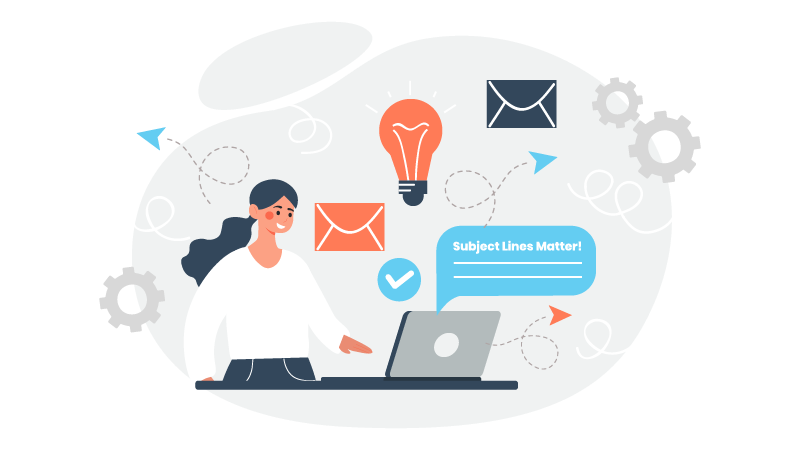The History of Email Marketing and Why It's Here to Stay
In the age of digital disruption, where attention spans are shorter than ever and traditional marketing channels are evolving rapidly, one tool has stood the test of time: email marketing.
But email marketing isn't just a modern phenomenon. It has a rich history that dates back decades.

At its core, email marketing involves sending targeted messages to a specific audience via email. These messages can include newsletters, promotional offers, product updates, and more. Email marketing is a direct and personalized form of communication that allows businesses to build relationships with their customers and drive conversions.
Why is email marketing so important? For starters, it's incredibly cost-effective compared to other marketing channels. With minimal upfront costs and the ability to reach a vast audience, email marketing offers a high ROI. Additionally, it's highly measurable. You can track open rates, click-through rates, and conversions to gain valuable insights into your campaigns' performance.
Email remains a cornerstone of effective marketing strategies despite the rise of social media and other digital platforms. In the following sections, we'll delve into the evolution of email marketing from its humble beginnings to its current state as a sophisticated and essential marketing tool.
The Birth of Email Marketing
The roots of email marketing can be traced back to the late 1970s, when the internet was still in its infancy. In 1978, a groundbreaking event occurred that would forever change the landscape of marketing: the sending of the first mass marketing email.
The pioneering email was sent by Gary Thuerk, a marketing executive at Digital Equipment Corporation (DEC). Thuerk used a newly developed email system to send a promotional message about DEC's new personal computer to potential customers. While the email was simple by today's standards, it marked a significant milestone in the history of email marketing.
The 1980s saw the emergence of email listservs, which allowed for the distribution of messages to a large group of subscribers. These early listservs were primarily used for academic and research purposes but soon found their way into the commercial sphere. Businesses began experimenting with using email to reach customers and promote their products and services.
However, the early days of email marketing were not without their challenges. One of the biggest obstacles was the lack of standardization. Email clients and servers were often incompatible, making sending and receiving messages reliably difficult. Additionally, no effective spam filters allowed unsolicited emails to flood inboxes and irritate recipients.
As the volume of spam increased, concerns about its impact on the internet grew. In response, governments worldwide began to introduce regulations to combat spam. One of the most significant pieces of legislation was the CAN-SPAM Act, passed by the US Congress in 2003. This law established rules for commercial email, including requirements for clear labeling and opt-out mechanisms.
The Rise of Graphical User Interfaces
The 1990s marked a turning point for email marketing as it became more accessible to the general public. The introduction of graphical user interfaces (GUIs) like Hotmail and Yahoo Mail made it easier for people to create, send, and receive emails. This increased adoption of email paved the way for its widespread use as a marketing tool.
In the late 1990s, a significant shift occurred in email marketing: the emergence of permission-based marketing. This approach emphasized obtaining explicit consent from individuals before sending them marketing emails. Permission-based marketing was more effective than traditional "spray and pray" methods, as it ensured that emails were sent to people interested in receiving them.
The rise of Email Service Providers (ESPs) also played a crucial role in the growth of email marketing. ESPs provided businesses the tools and infrastructure to manage email lists, create campaigns, and track performance. By automating many of the tasks involved in email marketing, ESPs allowed businesses to focus on creating high-quality content and building relationships with their customers.
As email marketing continued to evolve, the need for more efficient and effective ways to manage campaigns became apparent. This led to the introduction of marketing automation tools. These tools enabled businesses to automate tasks such as sending triggered emails, segmenting email lists, and scoring leads. By automating these processes, marketing automation tools helped businesses save time and improve their email marketing results.
The New Millennium: Personalization and Mobile Optimization
The 2000s marked a new era for email marketing, characterized by a growing emphasis on personalization and segmentation. As businesses sought to deliver more relevant and engaging content to their customers, they began experimenting with different ways to tailor their email campaigns.
One of the most effective personalization techniques was segmentation. By dividing email lists into smaller, more targeted segments based on demographics, interests, and behavior, businesses could send more relevant and engaging content to their subscribers. This led to higher open rates, click-through rates, and conversions.
In the mid-2000s, the explosion of mobile phone usage created a new challenge for email marketers: the need for mobile-friendly email design. As more people began checking their email on their smartphones and tablets, ensuring that emails were optimized for smaller screens became essential. Mobile-friendly email design not only improved the user experience but also helped to increase open rates and engagement.
The late 2000s also saw the rise of social media platforms like Facebook, Twitter, and Instagram. These platforms provided new opportunities for businesses to connect with their customers and promote their email marketing campaigns. Social media could drive traffic to email sign-up pages, promote new content, and encourage social sharing of email campaigns. Conversely, email marketing could drive engagement on social media platforms by sharing exclusive content or offering special promotions to email subscribers.
The Present (and Future) of Email Marketing
The Rise of AI and Machine Learning
The 2010s witnessed the emergence of artificial intelligence (AI) and machine learning (ML) as powerful tools for email marketing. These technologies enabled businesses to automate tasks, personalize content, and optimize campaigns in previously unimaginable ways.
AI and ML algorithms could analyze vast amounts of data to identify patterns and trends in customer behavior. This information could then be used to personalize email content, optimize sending times, and predict which subscribers would most likely convert. For example, AI-powered tools could recommend the best subject lines, optimize email layouts, and suggest personalized product recommendations based on a customer's browsing history.
Data Privacy and Security
As the digital landscape continued evolving, so did the regulatory environment. The 2020s saw a renewed focus on data privacy and security, with regulations like the General Data Protection Regulation (GDPR) and the California Consumer Privacy Act (CCPA) coming into effect. These regulations imposed strict requirements on businesses to protect their customers' information.
Email marketers must comply with data privacy regulations. Businesses must ensure that they have obtained proper consent from their subscribers, implement robust security measures, and provide transparency about how they collect and use customer data. Failure to comply with these regulations could result in hefty fines and damage to a company's reputation.
Emerging Trends
Modern email marketing practices and trends have evolved significantly in recent years, driven by technological advancements and changing consumer preferences. Businesses increasingly focus on delivering personalized and engaging content to their subscribers while prioritizing data privacy and security.
And despite the challenges posed by regulations, the future of email marketing remains bright:
-
Interactive Content: Personalized quizzes, polls, and gamification elements can enhance engagement and gather valuable customer insights.
-
Voice-Activated Email: Voice-controlled interactions and personalized recommendations can improve accessibility and provide a hands-free experience.
-
Augmented Reality (AR) and Virtual Reality (VR): Immersive experiences like product demos and virtual try-ons can enhance customer engagement.
-
Chatbots and Conversational AI: Automated customer support and personalized recommendations can streamline email interactions.
-
Integration with Other Channels: Combining email with social media, SMS, and other channels can create a more cohesive customer experience.
By staying up-to-date with current and growing trends, businesses can effectively leverage email marketing to build customer relationships, drive conversions, and achieve marketing goals.
Email Marketing: A Timeless Tool
Email marketing has come a long way since its humble beginnings in the late 1970s. From early spam-filled campaigns to today's highly personalized and data-driven strategies, email has proven to be a remarkably resilient and effective marketing tool. Its ability to reach a wide audience, deliver personalized content, and track results makes it an invaluable asset for businesses of all sizes.
As we look to the future, it's clear that email marketing will continue to evolve and adapt to new technologies and trends. By staying up-to-date with the latest best practices and leveraging innovative tools, businesses can maximize the potential of email marketing and achieve their marketing goals.
Are you ready to take your email marketing to the next level? Aspiration Marketing offers a comprehensive suite of services to help you create effective and engaging email campaigns. From strategy development to design and execution, our team of experts can help you achieve your marketing objectives.
Contact us today to learn more!
This content is also available in:
- German: Die Geschichte des E-Mail-Marketings und warum es von Dauer ist
- Spanish: Historia del Email Marketing y su permanencia
- French: L'histoire du marketing par e-mail et les raisons de sa pérennité
- Italian: La storia dell'email marketing e il motivo per cui resterà in vita
- Romanian: Istoria email marketing și de ce este aici pentru a rămâne
- Chinese: 电子邮件营销的历史及其长盛不衰的原因









Leave a Comment